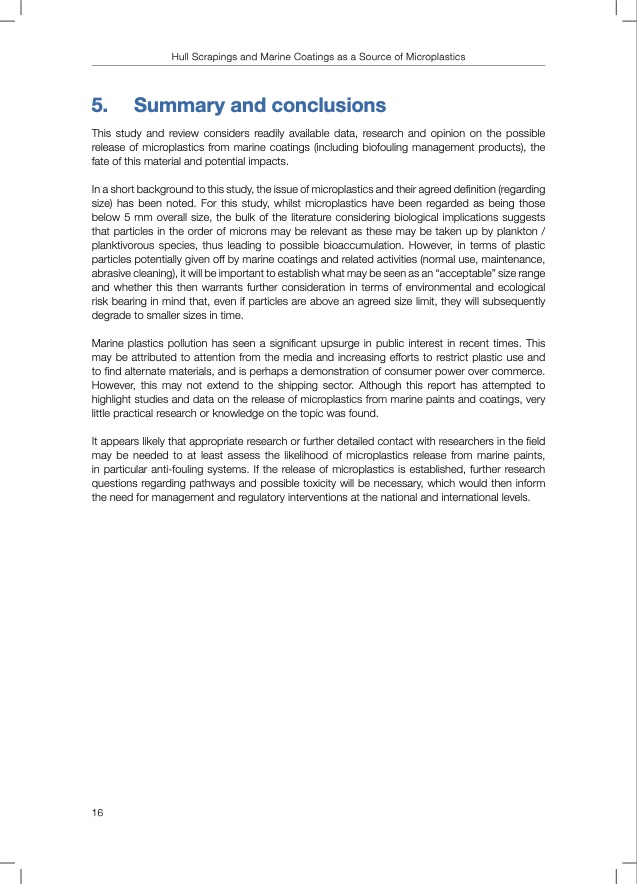
PDF Publication Title:
Text from PDF Page: 025
Hull Scrapings and Marine Coatings as a Source of Microplastics 5. Summary and conclusions This study and review considers readily available data, research and opinion on the possible release of microplastics from marine coatings (including biofouling management products), the fate of this material and potential impacts. In a short background to this study, the issue of microplastics and their agreed definition (regarding size) has been noted. For this study, whilst microplastics have been regarded as being those below 5 mm overall size, the bulk of the literature considering biological implications suggests that particles in the order of microns may be relevant as these may be taken up by plankton / planktivorous species, thus leading to possible bioaccumulation. However, in terms of plastic particles potentially given off by marine coatings and related activities (normal use, maintenance, abrasive cleaning), it will be important to establish what may be seen as an “acceptable” size range and whether this then warrants further consideration in terms of environmental and ecological risk bearing in mind that, even if particles are above an agreed size limit, they will subsequently degrade to smaller sizes in time. Marine plastics pollution has seen a significant upsurge in public interest in recent times. This may be attributed to attention from the media and increasing efforts to restrict plastic use and to find alternate materials, and is perhaps a demonstration of consumer power over commerce. However, this may not extend to the shipping sector. Although this report has attempted to highlight studies and data on the release of microplastics from marine paints and coatings, very little practical research or knowledge on the topic was found. It appears likely that appropriate research or further detailed contact with researchers in the field may be needed to at least assess the likelihood of microplastics release from marine paints, in particular anti-fouling systems. If the release of microplastics is established, further research questions regarding pathways and possible toxicity will be necessary, which would then inform the need for management and regulatory interventions at the national and international levels. 16PDF Image | HULL SCRAPINGS AND MARINE COATINGS AS A SOURCE OF MICROPLASTICS

PDF Search Title:
HULL SCRAPINGS AND MARINE COATINGS AS A SOURCE OF MICROPLASTICSOriginal File Name Searched:
Hull-Scrapings-report.pdfDIY PDF Search: Google It | Yahoo | Bing
Development of a solar powered Electric Ship The Electricship website originally started off as a project to develop a comprehensive renewable, affordable, modular electric ship... More Info
Modular Boat Hull Composite The case for a unsinkable, modular composite hybrid boat hull... More Info
MS Burgenstock Hybrid Electric Catamaran Lake Lucerne Unique shuttle servicing Lucerne to the Burgenstock Resort... More Info
Ground Power Unit GPU Powered by Lithium Ion Batteries The goal of the Ground Power Unit is to provide a readily accessible, modular, ready-to-power solution for remote power... More Info
| CONTACT TEL: 608-238-6001 Email: greg@electricship.com | RSS | AMP |